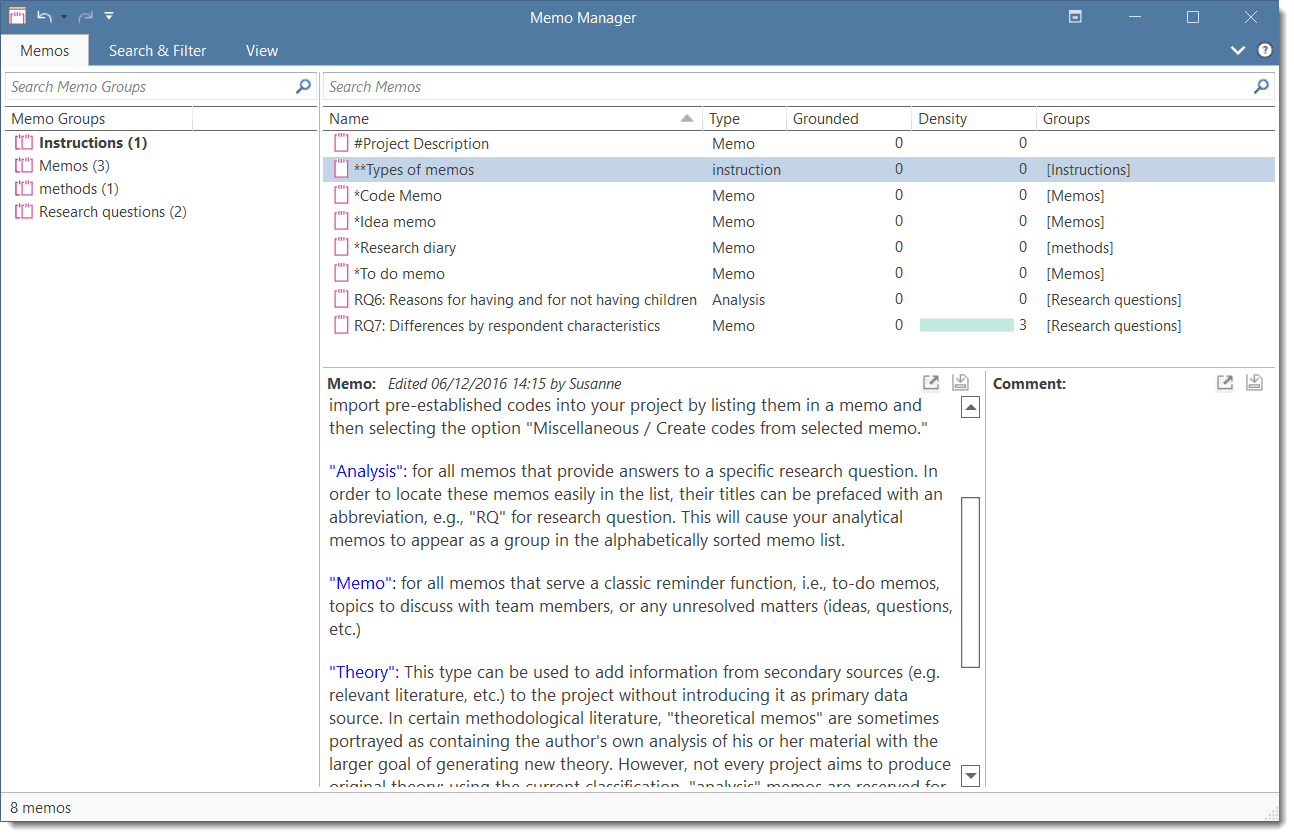Memos
Writing is an important part of analysis in qualitative research. When using software, it is easy to fall into the code trap. Always remember that coding the data is only a means to an end, to think, retrieve, and query data (Corbin and Strauss, 2015; Richards, 2009; Richards and Morse, 2013).
Memos are a bit more than just a short scribbled note in the margin area:
Memos [...] are working and living documents. When an analyst sits down to write a memo or do a diagram, a certain degree of analysis occurs. The very act of writing memos and doing diagrams forces the analyst to think about the data. And it is in thinking that analysis occurs (Corbin and Strauss, 2008: 118).
Writing is thinking. It is natural to believe that you need to be clear in your mind what you are trying to express first before you can write it down. However, most of the time, the opposite is true. You may think you have a clear idea, but it is only when you write it down that you can be certain that you do (or sadly, sometimes, that you do not) (Gibbs, 2005).
Memos thus represent analytical work in progress, and you can later use them as building blocks for your research report (see Friese, 2019). It is probably not by accident that Juliet Corbin includes a lot about memo writing in the third edition of Basics of Qualitative Research; she wants to show readers how it can be done. In a talk at the CAQD 2008 Conference about the book, she linked the poor quality of many of today’s qualitative research projects to a failure to use memos. Along the same lines, Birks et al. (2008) devotes an entire journal article to memo writing, criticizing the limited exploration of its value in most qualitative methodologies.
Freeman (2017) states that it is one of the challenges facing novice researchers to understand that writing is inseparable from analysis. We would like to encourage you do it: write a lot already while you code and later when you query the data. If you do it, you will find out why it is useful - but you've got to do it. As Freeman put it: The challenge for novice researchers is: “Needing to do analysis to understand analysis” (2017:3).
When you need more input regarding how to write memos see, for example, the third edition of Basics of Qualitative Research by Corbin and Strauss (2008/2014), Wolcott (2009), Charmaz (2014) or Friese (2019).
 In technical terms,
In technical terms,
-
A memo in ATLAS.ti may stand alone, or it may be linked to quotations, codes, and other memos.
-
Memos can be sorted by type (method, theoretical, descriptive, etc.), which is helpful in organizing and sorting them, or by creating memo groups.
-
Memos may also be included in the analysis as secondary data by converting them into a document. Then they can also be coded.
For more information, see Working with Comments and Memos.
References
Birks, Melanie; Chapman, Ysanne and Francis, Karin (2008). Memoing in qualitative research: probing data and processes, Journal of Research in Nursing, 13, 68–75.
Charmaz, Kathy (2014). Constructing Grounded Theory: A Practical Guide Through Qualitative Analysis. London: Sage.
Corbin, Juliet and Strauss, Anselm (2008/2015). Basics of Qualitative Research: Techniques and Procedures for Developing Grounded Theory (3rd and 4th ed.). Thousand Oaks, CA: Sage.
Freeman, Melissa (2017). Modes of Thinking for Qualitative Data Analysis. NY: Routledge.
Friese, Susanne (2019). Qualitative Data Analysis with ATLAS.ti (3. ed.), London: Sage.
Gibbs, Graham (2005). Writing as analysis. Online QDA.
Richards, Lyn and Morse, Janice M. (2013). Readme First for a User’s Guide to Qualitative Methods.
Richards, Lyn (2009). Handling qualitative data: a practical guide (2. ed), London: Sage.
Wolcott, Harry E. (2009). Writing Up Qualitative Research. London: Sage.